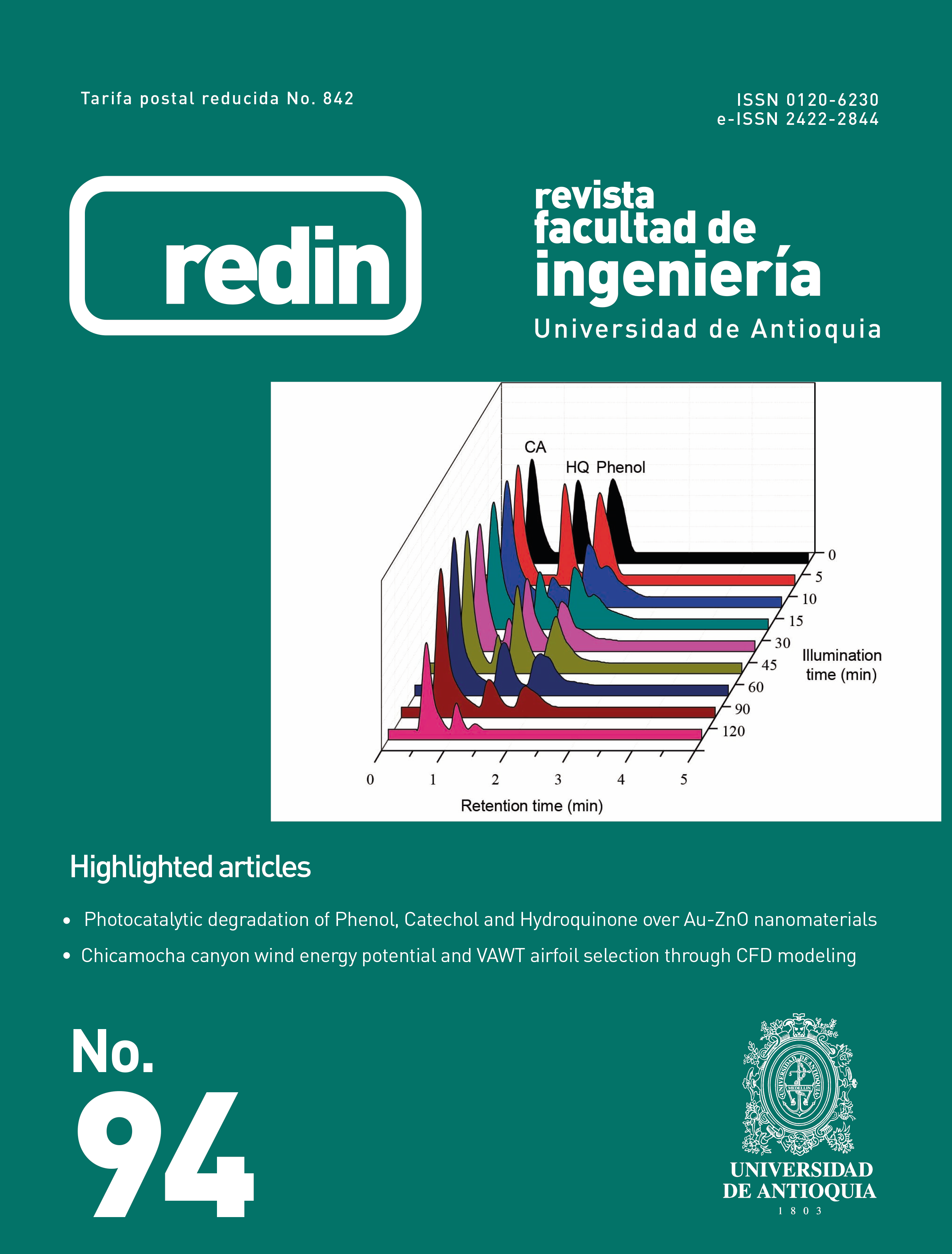Energía eólica del Cañón del Chicamocha y selección del perfil aerodinámico para una VAWT usando CFD
DOI:
https://doi.org/10.17533/udea.redin.20190512Palabras clave:
aerodinámica, CFD, Colombia, turbina, eólicaResumen
El uso de turbinas eólicas de eje vertical (VAWT) en Colombia podría abordar las dificultades de distribución de energía ya que gran extensión del territorio no está conectado a la red eléctrica. La presente investigación determina experimentalmente la potencia eólica disponible en el sector rural conocido como “Cañón del Chicamocha” y selecciona el perfil aerodinámico para diseñar un aspa de una VAWT por medio de simulación 2D en CFD. Tomando las características del viento del sitio de interés, se determina el desempeño aerodinámico de los perfiles NACA0018 y DU06W200 mediante el cálculo de sus coeficientes de sustentación y arrastre usando OpenFOAM considerando el modelo de turbulencia ”Spalart-Allmaras fv3”. Esta investigación muestra viable el uso de la energía eólica en el Cañón del Chicamocha al determinar la potencia eólica promedio anual de 485 [w/m2 ], además, sugiere construir los álabes de la turbina eólica usando el perfil aerodinámico DU06W200 al ser 14% más eficiente que el comercialmente usado NACA0018.
Descargas
Citas
Colombia: tendencias a largo plazo del sector energía en Colombia, Unidad de Planeación Minero Energética, Cartagena, Colombia, 2014.
E. M. Villammizar, “Estudio sobre el impacto turístico y económico del parque nacional del chicamocha en el municipio de san gil,” Ungraduathe thesis, Universidad Industrial de Santander, Santander, Colombia, 2007.
M. C. Claessens, “The design and testing of airfoils for application in small vertical axis wind turbines,” M.S. thesis, Delft University of Technology, Delft, Países Bajos, 2006.
M. Raciti, G. Simioni, and E. Benini, “Numerical analysis of the influence of airfoil asymmetry on vawt performance,” International Journal of Mechanical, Aerospace, Industrial, Mechatronic and Manufacturing Engineering, vol. 6, no. 1, pp. 75–84, 2012.
S. Hsing, W. W. Liou, A. Shabbir, Z. Yang, and J. Zhu, “A new k-eddy viscosity model for high reynolds number turbulent flows,” Computers & Fluids, vol. 24, no. 3, pp. 227–238, Mar. 1995.
C. Monir, C. Abhishek, and G. Bharat, “Cfd analysis of horizontal axis wind turbine blade for optimum value of power,” International Journal of Energy Environment, vol. 4, no. 5, pp. 825–834, 2013.
M. S. H. Boutilier, “Experimental investigation of transition over a NACA 0018 airfoil at a low reynolds number,” M.S. thesis, University of Waterloo, Ontario, Canada, 2011.
G. Elhussien, A. Hassan, and M. Elsayed, “Numerical Investigation of medium range Re numbers Aerodynamics Characteristics for NACA0018 Airfoil,” CFD Lett., vol. 6, no. 4, pp. 175–187, Mar. 2014.
K. Rogowski, M. O. Laver, and R. Maroński, “Steady and unsteadyanalysis of naca 0018 airfoil in vertical-axis wind turbine,” J. Theor. Appl. Mech., vol. 56, no. 1, pp. 203–212, 2018.
P. M. Kumar, R. Kulkarni, N. Srikanth, and L. Teik, “Performance assessment of darrieus turbine with modified trailing edge airfoil for low wind speeds,” Smart Grid and Renewable Energy, vol. 8, no. 12, pp. 425–439, Dec. 2017.
S. Yarusevych and M. S. H. Boutilier, “Vortex shedding of an airfoil at low reynolds numbers,” AIAA Journal, vol. 49, no. 10, pp. 2221–2227, 2011.
P. Spalart and S. Allmaras, “A one-equation turbulence model for aerodynamic flows,” presented at 30th Aerospace Sciences Meeting and Exhibit, Seattle, WA, 1992. [Online]. Available: https://arc.aiaa.org/doi/10.2514/6.1992-439
Cañón del chicamocha. [Google Maps]. Accessed Feb. 15, 2019. [Online]. Available: google.com/maps/place/Cañón+del+Chicamocha/@6.8126222,-72.998592,8984m/data=!3m1!1e3!4m5!3m4!1s0x8e6976f20decd421:0x201ace7fe50af23c!8m2!3d6.815869!4d-72.9897054
J. F. Manwell, J. G. McGowan, and A. L. Rogers, Wind Energy Explained, 2nd ed. Wiley, 2010.
D. C. Wilcox, Turbulence Modeling for CFD. La cañada, California: DCW Industries, 1994.
J. M. Fernández, Técnicas numéricas en ingeniería de fluidos: Introducción a la dinámica computacional de fluidos (CFD) por medio del método de volúmenes finitos, 1st ed. Barcelona, España: Editorial Reverté, 2012.
K. HyeongKim, Y. Soo, and M. Senda, “Large eddy simulation of turbulent flow past a square cylinder confined in a channel,”Computers & Fluids, vol. 3, no. 1, pp. 81–96, Jan. 2004.
Descargas
Publicado
Cómo citar
Número
Sección
Licencia
Derechos de autor 2020 Revista Facultad de Ingeniería Universidad de Antioquia

Esta obra está bajo una licencia internacional Creative Commons Atribución-NoComercial-CompartirIgual 4.0.
Los artículos disponibles en la Revista Facultad de Ingeniería, Universidad de Antioquia están bajo la licencia Creative Commons Attribution BY-NC-SA 4.0.
Eres libre de:
Compartir — copiar y redistribuir el material en cualquier medio o formato
Adaptar : remezclar, transformar y construir sobre el material.
Bajo los siguientes términos:
Reconocimiento : debe otorgar el crédito correspondiente , proporcionar un enlace a la licencia e indicar si se realizaron cambios . Puede hacerlo de cualquier manera razonable, pero no de ninguna manera que sugiera que el licenciante lo respalda a usted o su uso.
No comercial : no puede utilizar el material con fines comerciales .
Compartir igual : si remezcla, transforma o construye a partir del material, debe distribuir sus contribuciones bajo la misma licencia que el original.
El material publicado por la revista puede ser distribuido, copiado y exhibido por terceros si se dan los respectivos créditos a la revista, sin ningún costo. No se puede obtener ningún beneficio comercial y las obras derivadas tienen que estar bajo los mismos términos de licencia que el trabajo original.










 Twitter
Twitter